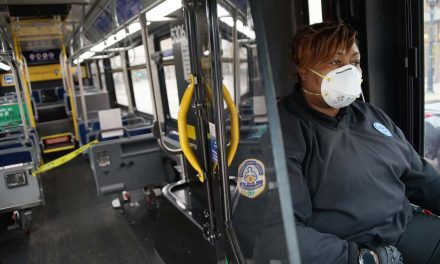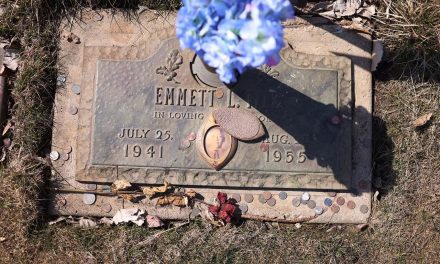
In late May, Mike Jackson collapsed on the job at Briggs & Stratton’s factory on Milwaukee’s Northwest Side. A few days later, on May 28, the 45-year-old father of eight died of COVID-19 after having worked for days or possibly weeks while he was ill with the deadly virus.
“Prior to that, he had been fighting to win protections against the spread of this pandemic in the workplace,” said Christine Neumann-Ortiz, director of Voces de la Frontera, the Milwaukee-based immigrant rights group, which conducted an online press conference on June 4 to draw attention to Jackson’s death.
His story shows that the viral illness, for which there is still neither a cure nor a vaccine, continues to lurk in the workplace even as businesses in Wisconsin and across the country are opening up under mounting political and economic pressure.
It also reflects an increasingly widespread reality of American workplaces: the pressure many workers may feel to keep going to work sick even when they should stay home and get well. Contributing to that reality are attendance policies that penalize workers for staying home, even when they have a documented illness. Such a policy was in place at Briggs & Stratton.
A Briggs & Stratton spokesman tells the Wisconsin Examiner that, during the COVID-19 pandemic, the company has made safety paramount, and that Briggs has not penalized workers who have stayed home either because of the illness or fear of coming down with it.
But critics of policies that automatically penalize absence, regardless of the cause, report that workers have found them confusing and are unclear about policy details that can threaten their job security. As a result, even well before the COVID-19 pandemic, some workers who fear being disciplined for taking a sick day have decided to go to work instead, risking their own health and that of their coworkers.
“It creates a power imbalance,” said Frank Kearl, a lawyer with Make the Road New York, an immigrant and worker rights group. Kearl represents Amazon workers there in disputes over the company’s leave and sick leave policies. Points-based absence policies are rare in New York City, he said, because of a city ordinance that requires all but the very smallest employers to provide 40 hours a year of paid leave for illness or for issues involving personal safety.
Elsewhere, though, variations on policies imposing discipline for absences, regardless of cause, have gained popularity. “It’s definitely gotten much more prevalent over the last decade or so,” said James Schultz, recording secretary for the Wisconsin Committee on Occupational Safety and Health (WISCOSH), a worker safety advocacy group.
Battling absenteeism
Attendance policies vary widely, and data on which are most common is hard to come by. But policies that assess points against a worker’s record for missing work or coming in late appear to be widespread.
Human resources consultants recommend any such policy have an escalating series of consequences, and points systems help keep track of infractions. As an employee accumulates points — sometimes called “occurrences” — they can reach the threshold for a verbal warning, followed by one or more written warnings, and possibly a suspension before termination.
Before the COVID-19 pandemic led many businesses to scale back operations or shut down entirely, laying off workers, for years employers had been complaining of challenges in finding enough workers.
“Attendance definitely has been problematic for many employers,” said Laurie Greenlees, director of the HR Hotline for MRA, a Waukesha-based employers association with operations in Wisconsin and other states. “In a lot of work environments, attendance is probably a number one reason for disciplinary issues that arise for termination.”
Greenlees said some employers impose attendance penalties for absences only after employees have used up their time off. Other attendance policies assess points for all unplanned absences.
That is tied to another trend: Some employers have stopped maintaining separate categories for paid sick time — if they offered it at all — and other forms of paid time off, such as vacation or personal days.
Attempted fairness
Joan C. Williams, a professor at the University of California-Hastings College of Law and founding director of the law school’s Center for WorkLife Law, said points-based policies were an attempt to make attendance policies more even-handed.
“The original motivation was well-intentioned,” Williams tells the Wisconsin Examiner. “The idea is that instead of just up and firing you [for a problem absence] you should have progressive discipline — which is something that unions have long bargained for.”
When paid time off and an attendance points system meet, the result is often a “no-fault” attendance policy. Under those policies, all absences need to be scheduled and approved in advance; emergency absences or arriving late to work, regardless of the reason, incur points. After a certain period of time with no more infractions, points drop off or reset to zero.
With a no-fault policy, “the employer doesn’t want to get into a long discussion about whether the employee’s reason for their inability to show up is legitimate or not,” Williams explains.
In a 2006 report, Williams examined union grievance arbitrations arising from conflicting work and family responsibilities for blue-collar and other working-class people. No-fault attendance policies, she found, have exacted a price from hourly workers who have been ignored when discussions of work/life flexibility center white-collar professionals.
“Some of the workers in the arbitrations discussed in this report have excellent attendance records, while many others have struggled with child care, elder care, transportation and other problems that have resulted in unenviable absenteeism records,” Williams wrote. “The issue is not whether employers have a right to count on employees to show up — clearly they do. The issue is whether employees who have done everything they could to put in place dependable routine and back-up care should be fired when a family emergency triggers the final point that leads them to be fired.”
Despite the good intentions of such policies, Williams said, they have penalized people who had to put their parental obligations ahead of their jobs — for example, arriving late to work because they had to stay home with their children until a tardy caregiver arrived.
“The problem comes when workers with family responsibilities are [assessed] points for doing something any responsible family member would do,” Williams said. And with the COVID-19 pandemic, “it’s particularly acute right now” as parents whose workplaces are reopening must grapple with the fact that schools or childcare facilities are still closed.
“When no fault attendance policies are used to give points to people who might be staying home because they’ve been exposed to COVID-19,” she adds, “that’s just a misuse of this kind of policy.”
Confusion on the frontlines
There are conflicting accounts of what was happening at Briggs & Stratton. During the Voces de la Frontera virtual news conference after Mike Jackson’s death, Chance Zombor, a Jackson co-worker, described conditions in which assembly line workers “are working in very close proximity to each other, with very little if any protection at all.”
Zombor is a United Steelworkers union grievance representative at Briggs and worker chair for the plant safety committee. In the factory, “there’s a lot of confusion on the floor” about COVID-19, he said.
The company offers short-term disability, which Jackson might have been able to use, “but the process was never laid out on how to go about doing that,” Zombor said. And Briggs has also said it would pay workers $375 a week if they have to stay home because of potential exposure to the virus.
“The company was never clear about the steps workers needed to take in order to put themselves on self-quarantine,” Zombor said. “So Mike worked for weeks while experiencing symptoms of COVID.”
Jackson went to work fearing he would be penalized for staying home, he added, and other workers have done the same.
“He was afraid of being ‘pointed,’” Zombor said. “You get a certain number of points a year [for absences] and it’s kind of hard to keep track of. You don’t want to rack up too many points … [or] you could just lose your job. That was Mike’s concern — he didn’t want to lose his job.”
Responding to an email inquiry from the Wisconsin Examiner, Rick Carpenter, Briggs & Stratton vice president for corporate marketing and communications, said that the company has been “very focused and vigilant in combating this virus and keeping our employees safe as they work.”
Briggs received a letter from Voces de la Frontera the same day as the organization’s virtual press conference, which was conducted on Zoom. “Not all that was shared on the Zoom call aligns with our understanding of the situation,” Carpenter said. “But we do plan on opening the lines of communication with Voces.”
Carpenter stated that Briggs has put out a “very clear and documented” safe workplace handbook for the pandemic calling for “thorough and frequent sanitation, social distancing, staggered breaks, reminders about proper hygiene, availability of masks and education for all of our locations, not just locally.”
The company has been consulting with the Wauwatosa Health Department and has been striving to follow Centers for Disease Control and Prevention (CDC) best practices, according to Carpenter.
“Additionally, we aren’t forcing anybody to come to work if they aren’t feeling well or don’t feel comfortable or safe, nor do we penalize them,” he said. “We further back this sentiment by providing compensation for those who test positive for COVID-19 and are placed on quarantine, as well as for those who choose to self-quarantine due to COVID-19 concerns.”
Making adjustments
Some employers are making adjustments to absence policies in response to the pandemic. Tom Niebuhr is a union representative for Sheet Metal-Air-Rail-Transportation (SMART) union local 565, which represents workers at about a dozen south central and central Wisconsin manufacturers. Many of those employers have attendance policies that take points off for absences, and they’ve agreed with the union to modify them during the pandemic.
Workers who report any of a number of symptoms related to COVID-19 are urged to stay away from work and won’t get charged with an occurrence, Niebuhr said. The same is true if they’re placed in quarantine by a health department or if they must stay home with children because school or child care facilities are closed.
Some employers have instituted pre-shift health screenings, taking workers’ temperatures before they go on the factory floor, Niebuhr adds. Workers who are sent home because of a fever in those screenings won’t be assessed for the absence, either.
MRA, the employer organization, surveyed more than 500 of its member companies and found more than one in three had adjusted attendance policies in recent weeks. “They’re doing it because they want to encourage sick employees to stay home,” said Greenlees.
Greenlees said employers should communicate clearly with employees about attendance policies, and she believes most do. Workers that Jim Schultz of WisCOSH hears from do not get that kind of communication, however.
“We’ve had complaints from workers who weren’t off sick but off for a workplace injury, and employers used it against them because it was considered a violation of their workplace absenteeism policy,” Schultz said — a tactic that he views as illegal retaliation for workplace injury.
He also hears from workers who don’t understand how their employers’ point systems work, or how to find out what their own record is for absences and where they are in the disciplinary progression.
Workers “have a right to go to their employer and say, ‘I want a copy of my work record,’” Schultz said. “Most workers don’t know that.”
Jirs Meuris, a professor of management and human resources at the University of Wisconsin-Madison, said that while no-fault and points-based policies offer procedural fairness by avoiding bias and subjective judgments, that comes at the expense of flexibility and discretion.
And if people are getting reprimands when they haven’t even realized they’ve been assessed points, “that’s probably on the company because they’re not communicating it in a good way,” he said. “Along with procedural justice and fairness, there also needs to be informational justice and fairness.”
Meuris questions whether these policies get at the root causes that lead some people to chronically miss work.
“You have to understand, why are people being absent?” he said. “Is it that they have low job satisfaction? Do they have to live a long distance from work?”
When people don’t show up, “these systems can help,” Meuris concludes. “But they don’t necessarily solve absenteeism.”
Originally published on the Wisconsin Examiner as When being sick prompts fears of being fired
Donate: Wisconsin Examiner
Help spread Wisconsin news, relentless reporting, unheard voices, and untold stories. Make a difference with a tax-deductible contribution to the Wisconsin Examiner














